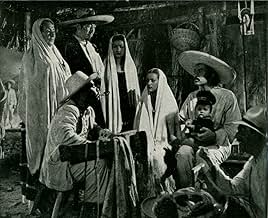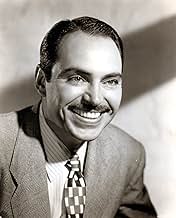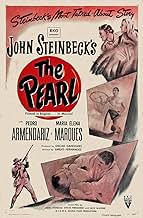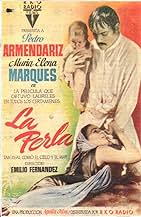IMDb रेटिंग
7.4/10
1.2 हज़ार
आपकी रेटिंग
अपनी भाषा में प्लॉट जोड़ेंThe discovery of a perfect pearl forever changes the lives of a poor Mexican fisherman and his family.The discovery of a perfect pearl forever changes the lives of a poor Mexican fisherman and his family.The discovery of a perfect pearl forever changes the lives of a poor Mexican fisherman and his family.
- पुरस्कार
- 9 जीत और कुल 6 नामांकन
José Arratia
- Tratante de perlas
- (बिना क्रेडिट के)
Guillermo Calles
- Indio rastreador
- (बिना क्रेडिट के)
Enrique Cancino
- Pueblerino
- (बिना क्रेडिट के)
Maria Elena Cuadros
- Juanita
- (बिना क्रेडिट के)
Columba Domínguez
- Pueblerina
- (बिना क्रेडिट के)
Enedina Díaz de León
- Yerbera
- (बिना क्रेडिट के)
Agustín Fernández
- Pueblerino
- (बिना क्रेडिट के)
Rogelio Fernández
- Pueblerino
- (बिना क्रेडिट के)
Raquel García
- Pueblerina
- (बिना क्रेडिट के)
फ़ीचर्ड समीक्षाएं
Apparently this piece is uncomfortable for people who simplify into moralism its complexity and forcefulness in what it has to say both explicitly and implicitly, aspirationism for wealth and the discord and greed it provokes, bourgeois class robbery of the working class, colonialist extractionism, whiteness as a jewel that gives privilege, all this as true then as it still is, set in a melodrama full of anguish, plus of course a beautiful montage in which the photography and the masterful underwater sequences stand out, marvellous at the time and which stand the test of time with great neatness.
Making an adaptation off John Steinbeck's short novel wasn't easy and always a feat.But Emilio Fernandez and Gabriel Figueroa did it in a succesful way.
Pedro Armendariz repeats on a high class of acting role as in 'Maria Candelaria'. Once again the cinematography of Gabriel Figueroa ranks among the best he's done. (the cinematography of this movie earned him, a prize at the Cannes Film Festival).
The aid of Mr. Steinbeck himself, helped Emilio to adapt the screenplay just as good as the novel itself.
This movie has no flaws and it ranks among the best in Mexico Film History, a must see.
Pedro Armendariz repeats on a high class of acting role as in 'Maria Candelaria'. Once again the cinematography of Gabriel Figueroa ranks among the best he's done. (the cinematography of this movie earned him, a prize at the Cannes Film Festival).
The aid of Mr. Steinbeck himself, helped Emilio to adapt the screenplay just as good as the novel itself.
This movie has no flaws and it ranks among the best in Mexico Film History, a must see.
10jotix100
"La Perla", the magnificent 1947 film directed by Emilio "El Indio" Fernandez is a testament to his genius. With the help of one of the greatest cinematographers the world has ever known, Gabriel Figueroa, we are treated to a tale of hope and greed set in the Pacific coast of Mexico. Based loosely on John Steinbeck's story, the author himself, helped enhance his own story with the screen treatment.
We are introduced to Quino and Juana and their infant son, living in poverty. They are starving because the seas have been too turbulent to go pearl fishing. They almost lose the boy that is bitten by a scorpion and the village doctor refuses to take care of the infant since they have no money. The village women nurse him back to health.
When Quino and Juana go fishing, he discovers a large and shiny pearl. This pearl will be their undoing. Quino is hoping for a better life for the boy, so that he doesn't have to lead their precarious life. Fate, on the other hand, intervenes as the beautiful pearl becomes the object of desire for the ruthless dealers, and the doctor, who want to steal it from Quino.
They end up fleeing their village. In a sequence that is as cruel, as it is beautiful, we see the fishers being pursued by the dealer and his Indian searchers, and the doctor through the mangroves first, and the arid countryside later on. Unfortunately, Quino and Juana are robbed of something more precious than the magnificent pearl that has been the object of their downfall.
Mr. Figueroa's cinematography feasts on the magnificent views of the region. The film looks as good today with the excellent copy that must have been restored because it has a pristine quality. Of course, nothing would have been possible with another director because Emilio Fernandez understood the people and was able to present his story in pure cinematic terms.
Pedro Armendariz, as Quino, makes one of the best appearances of his distinguished film career. He was an actor that clearly knew his subject and understood the man he was portraying. Maria Elena Marques is right as Juana, the caring woman and mother. Mr. Armendariz and Ms. Marques gave more than life to this couple.
What seems hard to understand was the casting of Charles Rooner as the evil doctor, or Fernando Wagner, as the crooked dealer, for that matter. Both speak Spanish with a heavy French accent, something that doesn't feel right, but maybe, on the other hand, the director and the writers felt that by having foreigners try to cheat Quino and Juana set the right tone for the story.
Also, the insertion of the fiesta sequence, while lovely to look at, it seems something right out of the Ballet Folklorico and too elaborate for the conditions in which most of the fishermen lived! It's nice to have heard a stylized version of La Bamba, but somehow, it distracts from reality.
"La Perla" was a monumental achievement thanks to Mr. Fernandez's and Mr. Figueroa's inspired take on the Steinbeck story.
We are introduced to Quino and Juana and their infant son, living in poverty. They are starving because the seas have been too turbulent to go pearl fishing. They almost lose the boy that is bitten by a scorpion and the village doctor refuses to take care of the infant since they have no money. The village women nurse him back to health.
When Quino and Juana go fishing, he discovers a large and shiny pearl. This pearl will be their undoing. Quino is hoping for a better life for the boy, so that he doesn't have to lead their precarious life. Fate, on the other hand, intervenes as the beautiful pearl becomes the object of desire for the ruthless dealers, and the doctor, who want to steal it from Quino.
They end up fleeing their village. In a sequence that is as cruel, as it is beautiful, we see the fishers being pursued by the dealer and his Indian searchers, and the doctor through the mangroves first, and the arid countryside later on. Unfortunately, Quino and Juana are robbed of something more precious than the magnificent pearl that has been the object of their downfall.
Mr. Figueroa's cinematography feasts on the magnificent views of the region. The film looks as good today with the excellent copy that must have been restored because it has a pristine quality. Of course, nothing would have been possible with another director because Emilio Fernandez understood the people and was able to present his story in pure cinematic terms.
Pedro Armendariz, as Quino, makes one of the best appearances of his distinguished film career. He was an actor that clearly knew his subject and understood the man he was portraying. Maria Elena Marques is right as Juana, the caring woman and mother. Mr. Armendariz and Ms. Marques gave more than life to this couple.
What seems hard to understand was the casting of Charles Rooner as the evil doctor, or Fernando Wagner, as the crooked dealer, for that matter. Both speak Spanish with a heavy French accent, something that doesn't feel right, but maybe, on the other hand, the director and the writers felt that by having foreigners try to cheat Quino and Juana set the right tone for the story.
Also, the insertion of the fiesta sequence, while lovely to look at, it seems something right out of the Ballet Folklorico and too elaborate for the conditions in which most of the fishermen lived! It's nice to have heard a stylized version of La Bamba, but somehow, it distracts from reality.
"La Perla" was a monumental achievement thanks to Mr. Fernandez's and Mr. Figueroa's inspired take on the Steinbeck story.
By the advent of the pearl, everyone appears to be changed in character into a monster of greed, except the protagonists, the fisherman, his wife and their baby, who instead turn into refugees and victims. It's an anatomy of greed with a definite morality, that a great fortune must lead to greed, criminality, death and loneliness. It doesn't have to be like that, but in this story, that is definitely the case in hopeless despair with no illusions surviving, As the pearl enters their lives they start dreaming of all the possibilities it imports, and there is great festivity in the entire village, as all the poor people rejoice in the fisherman's good fortune, but there are always opportunists, and at the appearance of a chance of fortune they will go at any length and sacrifice all human values for their greed. A return to absolute poverty seems to be the only solution to the problem. John Steinbeck's story is a grim study in the weakness of common man, what is lacking here is any wisdom in any man, the fisherman doesn't even have any reliable friend whom he can trust for advice, and the one who helps him gets shot for it. It is impossible not to have objections against such a hopelessly dark and bleak assessment of man, since there must be alternatives. Nothing is completely black, and although the fisherman and his wife survive their via crucis, there must be a new life for them.
This is a wonderfully shot film whose story, while not totally believable, could serve as allegory. Perhaps the family of the Mexican fisherman-diver played by Armendariz would have been happier if he had not discovered the pearl at all, but the poverty that endangers their baby's life makes his joy at this discovery (in a good underwater scene) credible. Immediately afterward, he finds himself beset by freeloaders and robbers (including his own brother), and the spiral continues until it ends in flight, hunger, death and a sort of redemption: the pearl is hurled back into the sea that spawned it. Apart from the story, the highlight is the Mexican scenery, the village and villagers, and the skillful and evocative camera angles. As one reviewer wrote, it's unlikely a villagers' celebration would have been as elaborate as the one shown in "La Perla," but it is enjoyable. Perhaps one semi-cynical message that could be gained from this film is that if you strike it rich, tell as few people as possible.
क्या आपको पता है
- ट्रिवियाEmilio Fernández, who was in love with Olivia de Havilland, thought she was the ideal actress to play the female starring role. De Havilland never knew of his secret love, but the director was able to get the government of Mexico City to change the name of the street he grew up on to "Dulce Olivia" (Sweet Olivia).
- भाव
Narrator: This is a story that old men tell to children. They aren't sure where it happened or when.
- इसके अलावा अन्य वर्जनA short version (77') was shown in the USA, France and West Germany whereas a longer version (85 to 87') was shown in Mexico and East Germany.
टॉप पसंद
रेटिंग देने के लिए साइन-इन करें और वैयक्तिकृत सुझावों के लिए वॉचलिस्ट करें
- How long is The Pearl?Alexa द्वारा संचालित
विवरण
- चलने की अवधि1 घंटा 25 मिनट
- रंग
- पक्ष अनुपात
- 1.37 : 1
इस पेज में योगदान दें
किसी बदलाव का सुझाव दें या अनुपलब्ध कॉन्टेंट जोड़ें

























